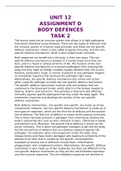UNIT 12
ASSIGNMENT D
BODY DEFENCES
TASK 2
The human body has an immune system that allows it to fight pathogens
that would otherwise cause diseases. There are two types of defences that
the immune system of a human body provides, and these are the specific
defence mechanism, which is also called acquired immunity, and the non-
specific defence mechanism, which is also called innate immunity.
Both responses are beneficial to the body in their own ways. The non-
specific defence mechanism is present in a human body since they are
born, and it is found in almost all forms of life. The function of the non-
specific defence mechanisms is to prevent pathogens from entering the
body and they repel all foreign invaders equally whether they are a virus,
bacteria, protozoans, fungi, or worms. Exposure to any pathogen triggers
an immediate response that destroys the pathogen right away.
Alternatively, the specific defence mechanism only comes into action
when a specific pathogen exceeds the non-specific defence mechanism.
The specific defence mechanism involves cells and proteins that are
combined in the blood and lymph, which attach to the foreign invader to
destroy, disarm, and remove it. This provides a long term and effective
immunity against specific pathogens that may enter the body again. This
mechanism improves and develops the activity of the non-specific
defence mechanism.
Both defence mechanisms, non-specific and specific, are made up of two
components. However, the non-specific defence mechanism is made up of
two types of responses, which are the first line of defence and the second
line of defence. The first line of defence is known as the passive immunity.
This is when the body prevents a pathogen from entering by utilizing the
body’s natural barriers such as skin, chemical in tears, chemicals in sweat,
and stomach acid. Moreover, the second line of defence is known as the
active immunity. This is when the pathogen manages to get into the body
but the second line of defence acts as a backup response against the
pathogen. For example, when microorganisms enter the body, they
release toxins and these toxins damaged cells leading to symptoms of the
disease to be seen that is caused by the specific microorganism.
Examples of second line of defences include fever, inflammation,
phagocytosis, and complement protein. Alternatively, the specific defence
mechanism is also made up of two responses, but they are different to the
non-specific defence mechanism as they are the cell-mediated responses
and the humoral responses. The cell-mediated responses are devised to




